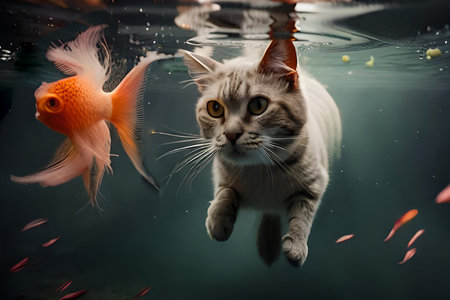Understanding Fish Stress: What It Is and Why It Matters
When it comes to aquarium fish, stress isn’t just a minor inconvenience—it’s a major factor that can impact your pets’ health, longevity, and overall well-being. Unlike humans, fish can’t tell us when they’re feeling stressed, but their bodies react in ways that can be extremely harmful if not addressed promptly. Stress in fish refers to any condition or change in their environment that causes discomfort or disrupts their normal biological processes. This could be due to poor water quality, sudden changes in temperature, overcrowding, aggressive tank mates, or even loud noises near the aquarium.
How Does Stress Affect Aquarium Fish?
When fish are stressed, their immune systems weaken, making them more susceptible to diseases such as ich, fin rot, or bacterial infections. Chronic stress can also disrupt their eating habits and breeding behaviors. Here’s a quick overview of common stressors and their potential impact:
| Common Stressor | Potential Impact on Fish |
|---|---|
| Poor Water Quality | Weakened immune system, increased disease risk |
| Sudden Temperature Changes | Shock, decreased appetite, lethargy |
| Overcrowding | Aggression, competition for resources |
| Noisy Environment | Panic, erratic swimming, hiding behavior |
Why Should Fish Owners Take Stress Seriously?
For aquarium enthusiasts in the U.S., understanding the impact of stress on fish is crucial because it directly affects both the health of the fish and the enjoyment of keeping an aquarium. Stress-related illnesses are among the leading causes of death in pet fish. If left unchecked, stress can quickly escalate from minor behavioral changes to life-threatening conditions. Being proactive about minimizing stress isn’t just about preventing illness—it’s about creating a thriving aquatic environment where your fish can display natural behaviors and vibrant colors.
2. Common Causes of Stress in Aquarium Fish
Stress is one of the leading contributors to illness and even death in aquarium fish. Understanding the main causes can help you create a healthier, more stable environment for your aquatic pets. The most frequent sources of stress in a home aquarium revolve around water quality issues, inappropriate tank mates, and sudden changes in the fish’s environment.
Water Quality Issues
Poor water quality is by far the most common cause of stress for aquarium fish. Factors such as high ammonia or nitrite levels, drastic pH swings, and incorrect temperatures can quickly become dangerous. Fish rely on clean, stable water conditions to thrive, and even minor fluctuations can be harmful.
| Water Parameter | Ideal Range | Effects of Imbalance |
|---|---|---|
| Ammonia (NH3) | 0 ppm | Toxicity, respiratory distress |
| Nitrite (NO2-) | 0 ppm | Lethargy, increased disease risk |
| Nitrate (NO3-) | <20 ppm (freshwater), <10 ppm (saltwater) | Long-term health decline |
| pH | Depends on species (usually 6.5-8.0) | Stress, inability to regulate bodily functions |
| Temperature | Species-specific (generally 72–82°F for tropical fish) | Slowed metabolism or shock |
Improper Tank Mates
Selecting incompatible tank mates can lead to aggression, bullying, or competition for resources. This constant social stress can suppress immune function and increase the likelihood of injury or disease outbreaks. Always research the temperament and size compatibility of any new additions before introducing them into your aquarium.
Common Problems with Tank Mates:
- Aggression: Territorial or predatory species may harass peaceful fish.
- Bullies: Some fish nip fins or chase others relentlessly.
- Overcrowding: Too many fish increases waste and stress from competition.
- Mismatched environmental needs: Fish with different temperature or pH requirements may not thrive together.
Sudden Environmental Changes
Aquarium fish are highly sensitive to abrupt changes in their surroundings. Events such as large water changes with mismatched temperature or chemistry, moving decorations, or turning lights on and off suddenly can all trigger acute stress responses. It’s essential to make adjustments gradually and keep routines consistent whenever possible.
Key Takeaway:
If you want to keep your fish healthy and stress-free, focus on maintaining excellent water quality, choosing compatible tank mates, and making all environmental changes slowly and thoughtfully.
![]()
3. Signs Your Fish May Be Stressed
Recognizing the signs of stress in your fish is crucial for preventing illness and promoting a healthy aquarium environment. Stress can manifest in both behavioral and physical ways, and understanding these indicators can help you take prompt action before problems escalate.
Behavioral Symptoms of Stress in Fish
Fish often show changes in their normal behavior when stressed. Here are some common behavioral signs to watch for:
| Behavioral Sign | Description |
|---|---|
| Erratic Swimming | Darting around the tank, bumping into objects, or swimming in circles |
| Lethargy | Spending more time hiding, staying near the bottom, or being less active than usual |
| Loss of Appetite | Refusing food or eating significantly less than normal |
| Gasping at Surface | Frequently coming to the waters surface as if struggling to breathe (can indicate poor oxygenation or water quality) |
| Aggression or Withdrawal | Becoming unusually aggressive with tank mates or avoiding social interaction entirely |
Physical Symptoms of Stress and Illness
Alongside behavioral changes, physical symptoms may also develop in stressed or unwell fish. Pay attention to these warning signs:
| Physical Symptom | Description |
|---|---|
| Color Fading or Darkening | Dull or unusually dark coloration compared to normal appearance |
| Torn or Clamped Fins | Fins appearing pinched close to the body, frayed, or damaged |
| White Spots or Patches | Signs of parasites (like Ich) or fungal infections; look for white spots on fins, scales, or gills |
| Rapid Gill Movement | Breathe rapidly even when at rest, often due to poor water quality or toxins in the tank |
| Sores or Red Streaks on Body/Fins | Open wounds, ulcers, or visible red lines may indicate bacterial infection or injury from stressors like rough handling or aggression from other fish |
Why Early Detection Matters
If you notice any of these symptoms in your aquarium, it’s important to address potential causes of stress quickly. Early detection not only improves your fish’s chances of recovery but also helps prevent contagious illnesses from spreading throughout your tank. In the next section, we’ll explore effective strategies to reduce stress and protect your aquatic pets from disease.
4. How Stress Can Lead to Illness or Death in Fish
Chronic stress is a serious threat to your fish’s health, and understanding the connection between ongoing stress and illness is key to keeping your aquatic pets safe. When fish experience prolonged stress, their immune system weakens, making them much more vulnerable to diseases caused by bacteria, fungi, and parasites. This can eventually lead to fatal outcomes if not addressed.
The Impact of Chronic Stress on Fish Health
Just like humans, fish have a natural “fight or flight” response to sudden threats. However, if stressful conditions persist—such as poor water quality, overcrowding, or incompatible tank mates—their bodies remain in a heightened state of alert. This constant stress suppresses their immune function, slows growth, disrupts normal behaviors, and impacts reproduction.
How Prolonged Stress Increases Disease Susceptibility
| Stressor | Immune System Effect | Potential Illnesses |
|---|---|---|
| Poor Water Quality | Reduces white blood cell count | Fin rot, bacterial infections |
| Overcrowding | Increases disease transmission | Ich (white spot), fungal outbreaks |
| Sustained Aggression | Causes chronic injury and stress hormones | Open wounds, secondary infections |
Why Prolonged Stress Can Be Fatal
If these issues aren’t corrected, your fish may become lethargic, stop eating, and show visible signs of illness such as faded colors or abnormal swimming. Ultimately, the combination of weakened immunity and ongoing exposure to pathogens can result in severe illness or even death. Monitoring for early signs of stress and maintaining optimal tank conditions are vital steps in preventing this dangerous downward spiral.
5. Tips for Minimizing Stress and Creating a Healthy Environment
Reducing stress is essential for keeping your fish healthy and preventing illness. Below, you’ll find practical advice on how to create an optimal environment, maintain your aquarium, and select the right companions for your aquatic pets.
Best Practices for Tank Setup
| Aspect | Recommendation |
|---|---|
| Tank Size | Choose a tank that’s appropriately sized for your fish species and planned number of inhabitants. Overcrowding leads to stress and aggression. |
| Water Parameters | Maintain stable temperature, pH, ammonia, nitrite, and nitrate levels according to the needs of your specific fish. Use a reliable test kit regularly. |
| Filtration & Aeration | Install a quality filter suitable for your tank size and provide adequate water movement to ensure oxygenation. |
| Aquascaping & Hiding Spots | Add live or artificial plants, rocks, and caves to create hiding places. This helps fish feel secure and reduces territorial disputes. |
| Lighting | Provide a consistent light cycle (typically 8-12 hours per day) with periods of darkness to mimic natural conditions and reduce stress. |
Regular Maintenance Routines
- Water Changes: Perform partial water changes (20-30%) weekly or bi-weekly to remove toxins and replenish minerals.
- Clean the Substrate: Vacuum gravel or substrate during water changes to remove uneaten food and waste.
- Monitor Equipment: Check heaters, filters, and lights regularly to ensure they are functioning properly.
- Test Water Quality: Test water parameters at least once a week or after any significant changes in the tank.
- Avoid Sudden Changes: Make adjustments to water temperature, chemistry, or décor gradually to avoid shocking your fish.
Choosing Compatible Tank Mates
Selecting the right mix of fish is crucial for minimizing aggression and stress. Consider these guidelines:
- Research Species Compatibility: Avoid mixing aggressive species with peaceful ones. Stick to fish with similar temperaments and environmental needs.
- Schooling Fish: Many species prefer to be kept in groups. Ensure you have enough individuals of schooling species to make them feel secure.
- Avoid Overcrowding: Provide ample space for each fish based on their adult size and swimming habits.
- Add New Fish Carefully: Quarantine new arrivals before introducing them to the main tank to prevent disease transmission.
The Bottom Line: A Calm Tank Is a Healthy Tank
By following these tips for tank setup, ongoing maintenance, and thoughtful selection of tank mates, you can significantly reduce stress in your aquarium. Remember, happy and relaxed fish are less prone to illness—and much more enjoyable to watch!
6. What to Do If You Suspect Your Fish Are Stressed
If you notice signs of stress in your aquarium fish—such as erratic swimming, loss of appetite, faded coloration, clamped fins, or hiding more than usual—it’s important to act quickly. Chronic stress can weaken their immune system and make them susceptible to illness or even death. Here’s a step-by-step guide on what you should do:
Immediate Steps to Reduce Stress
| Step | Action |
|---|---|
| 1. Assess Water Quality | Test for ammonia, nitrites, nitrates, pH, and temperature. Correct any imbalances immediately. |
| 2. Check Tankmates | Observe for bullying or aggression. Separate aggressive fish if needed. |
| 3. Review Habitat | Add hiding spots (plants, caves), ensure proper lighting and reduce sudden changes. |
| 4. Minimize Disturbance | Limit tapping on glass, frequent tank rearrangement, or loud noises near the aquarium. |
| 5. Maintain Routine | Feed at regular times with high-quality food and perform consistent water changes. |
When to Consult a Vet or Aquatic Specialist
If your fish do not improve within a few days despite your efforts, or if you notice symptoms such as white spots, open sores, rapid gill movement, bloating, or unusual growths, it’s time to reach out to a vet or aquatic specialist. Many cities in the U.S. have vets who specialize in fish health, and some pet stores can refer you to local experts.
Signs That Require Professional Help
- No improvement after correcting water quality and environment
- Visible wounds, ulcers, or external parasites
- Lethargy paired with abnormal swimming patterns
- Sudden deaths of multiple fish in a short period
Tip:
If you need to transport your fish for veterinary care, use clean water from their tank in a secure container and minimize transport time.


